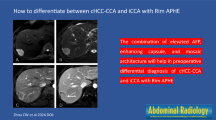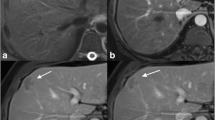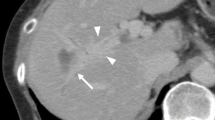Abstract
Non-invasive diagnosis of hepatocellular carcinoma (HCC) in cirrhotic patients requires demonstration of wash-in and wash-out on contrast-enhanced imaging. Recent studies have reported misclassification of mass-forming intrahepatic cholangiocarcinoma (MFCCC) as HCC. We aimed to analyze the contrast enhancement patterns of MFCCC, focusing especially on lesions mimicking HCC. We retrospectively evaluated all consecutive patients with MFCCC who underwent surgery between 2007 and 2017. Patients with mixed HCC–MFCCC were excluded. Two expert radiologists reviewed preoperative CT and MRI. Full-nodule hyperenhancement in the arterial phase in conjunction with hypoenhancement in the portal/late phase was classified as an “HCC-like pattern”. Imaging of MFCCCs with an HCC-like pattern was reviewed by an additional radiologist blinded to clinical data. Ninety-two patients were analyzed. All patients were investigated with multiphase CT and 85 with MRI. Twelve tumors (13%) showed full-nodule arterial hyperenhancement. Of these, four were hypoenhancing in the portal/late phase. Overall, 4/92 (4%) MFCCCs (4/45 in patients with cirrhosis/hepatitis, 9%) showed an HCC-like pattern accounting for misclassification as HCC on imaging review. HCC-like MFCCCs accounted for 9% of single tumors ≤ 50 mm. All HCC-like MFCCCs occurred in patients with cirrhosis or hepatitis, whereas only 47% of non-HCC-like MFCCCs did so (p = 0.053). After a median follow-up of 29 months, all patients with HCC-like MFCCCs are alive and disease free (median 64 months). In conclusion, MFCCC was misdiagnosed as typical HCC in 4% of all cases and in 9% of patients with single tumors ≤ 50 mm or with cirrhosis/hepatitis. The risk of misdiagnosis should be considered prior to treatment planning.

Similar content being viewed by others
Abbreviations
- HCC:
-
Hepatocellular carcinoma
- MFCCC:
-
Mass-forming intrahepatic cholangiocellular carcinoma
- CT:
-
Computed tomography
- MRI:
-
Magnetic resonance imaging
- OS:
-
Overall survival
- PET/CT:
-
Positron emission tomography/computed tomography
- LI-RADS:
-
Liver imaging reporting and data system
- IQR:
-
Interquartile ranges
- AFP:
-
Alpha-fetoprotein
- CEUS:
-
Contrast-enhanced ultrasonography
- DWI:
-
Diffusion-weighted magnetic resonance imaging
References
Banales JM, Cardinale V, Carpino G et al (2016) Expert consensus document: cholangiocarcinoma: current knowledge and future perspectives consensus statement from the European Network for the Study of Cholangiocarcinoma (ENS-CCA). Nat Rev Gastroenterol Hepatol 13:261–280. https://doi.org/10.1038/nrgastro.2016.51
Saha SK, Zhu AX, Fuchs CS, Brooks GA (2016) Forty-year trends in cholangiocarcinoma incidence in the U.S.: intrahepatic disease on the rise. Oncologist 21:594–599. https://doi.org/10.1634/theoncologist.2015-0446
Khan SA, Toledano MB, Taylor-Robinson SD (2008) Epidemiology, risk factors, and pathogenesis of cholangiocarcinoma. HPB (Oxford) 10:77–82. https://doi.org/10.1080/13651820801992641
de Jong MC, Nathan H, Sotiropoulos GC et al (2011) Intrahepatic cholangiocarcinoma: an international multi-institutional analysis of prognostic factors and lymph node assessment. J Clin Oncol 29:3140–3145. https://doi.org/10.1200/JCO.2011.35.6519
Kim Y, Moris DP, Zhang X-F et al (2017) Evaluation of the 8th edition American Joint Commission on Cancer (AJCC) staging system for patients with intrahepatic cholangiocarcinoma: a surveillance, epidemiology, and end results (SEER) analysis. J Surg Oncol 116:643–650
Si A, Li J, Xiang H et al (2017) Actual over 10-year survival after liver resection for patients with intrahepatic cholangiocarcinoma. Oncotarget 8:44521–44532. https://doi.org/10.18632/oncotarget.17815
Farges O, Fuks D, Boleslawski E et al (2011) Influence of surgical margins on outcome in patients with intrahepatic cholangiocarcinoma: a multicenter study by the AFC-IHCC-2009 study group. Ann Surg 254:824–829
Ribero D, Pinna AD, Guglielmi A et al (2012) Surgical approach for long-term survival of patients with intrahepatic cholangiocarcinoma: a multi-institutional analysis of 434 patients. Arch Surg 147:1107–1113. https://doi.org/10.1001/archsurg.2012.1962
Conci S, Ruzzenente A, Viganò L et al (2018) Patterns of distribution of hepatic nodules (single, satellites or multifocal) in intrahepatic cholangiocarcinoma: prognostic impact after surgery. Ann Surg Oncol 25:3719–3727. https://doi.org/10.1245/s10434-018-6669-1
Zhou Y, Zhao Y, Li B et al (2012) Hepatitis viruses infection and risk of intrahepatic cholangiocarcinoma: evidence from a meta-analysis. BMC Cancer 12:289. https://doi.org/10.1186/1471-2407-12-289
Palmer WC, Patel T (2012) Are common factors involved in the pathogenesis of primary liver cancers? A meta-analysis of risk factors for intrahepatic cholangiocarcinoma. J Hepatol 57:69–76. https://doi.org/10.1016/j.jhep.2012.02.022
Oishi N, Kumar MR, Roessler S et al (2012) Transcriptomic profiling reveals hepatic stem-like gene signatures and interplay of miR-200c and epithelial-mesenchymal transition in intrahepatic cholangiocarcinoma. Hepatology 56:1792–1803. https://doi.org/10.1002/hep.25890
Iavarone M, Piscaglia F, Vavassori S et al (2013) Contrast enhanced CT-scan to diagnose intrahepatic cholangiocarcinoma in patients with cirrhosis. J Hepatol 58:1188–1193. https://doi.org/10.1016/j.jhep.2013.02.013
Zhao Y-J, Chen W-X, Wu D-S et al (2016) Differentiation of mass-forming intrahepatic cholangiocarcinoma from poorly differentiated hepatocellular carcinoma: based on the multivariate analysis of contrast-enhanced computed tomography findings. Abdom Radiol 41:978–989. https://doi.org/10.1007/s00261-015-0629-z
Tsunematsu S, Chuma M, Kamiyama T et al (2015) Intratumoral artery on contrast-enhanced computed tomography imaging: differentiating intrahepatic cholangiocarcinoma from poorly differentiated hepatocellular carcinoma. Abdom Imaging 40:1492–1499. https://doi.org/10.1007/s00261-015-0352-9
Rimola J, Forner A, Reig M et al (2009) Cholangiocarcinoma in cirrhosis: absence of contrast washout in delayed phases by magnetic resonance imaging avoids misdiagnosis of hepatocellular carcinoma. Hepatology 50:791–798. https://doi.org/10.1002/hep.23071
European Association for the Study of the Liver (2018) easl clinical practice guidelines: management of hepatocellular carcinoma. J Hepatol 69:182–236. https://doi.org/10.1016/j.jhep.2018.03.019
Marrero JA, Kulik LM, Sirlin CB et al (2018) Diagnosis, staging, and management of hepatocellular carcinoma: 2018 practice guidance by the American association for the study of liver diseases. Hepatology 68:723–750. https://doi.org/10.1002/hep.29913
Ciresa M, De Gaetano AM, Pompili M et al (2015) Enhancement patterns of intrahepatic mass-forming cholangiocarcinoma at multiphasic computed tomography and magnetic resonance imaging and correlation with clinicopathologic features. Eur Rev Med Pharmacol Sci 19:2786–2797
Li R, Cai P, Ma K-S et al (2016) Dynamic enhancement patterns of intrahepatic cholangiocarcinoma in cirrhosis on contrast-enhanced computed tomography: risk of misdiagnosis as hepatocellular carcinoma. Sci Rep 6:26772. https://doi.org/10.1038/srep26772
Huang B, Wu L, Lu X-Y et al (2016) Small intrahepatic cholangiocarcinoma and hepatocellular carcinoma in cirrhotic livers may share similar enhancement patterns at multiphase dynamic MR imaging. Radiology 281:150–157. https://doi.org/10.1148/radiol.2016151205
Mendiratta-Lala M, Gu E, Owen D et al (2018) Imaging findings within the first 12 months of hepatocellular carcinoma treated with stereotactic body radiation therapy. Int J Radiat Oncol Biol Phys 102:1063–1069. https://doi.org/10.1016/j.ijrobp.2017.08.022
Kim SJ, Lee JM, Han JK et al (2007) Peripheral mass-forming cholangiocarcinoma in cirrhotic liver. AJR Am J Roentgenol 189:1428–1434. https://doi.org/10.2214/AJR.07.2484
Kim SA, Lee JM, Lee KB et al (2011) Intrahepatic mass-forming cholangiocarcinomas: enhancement patterns at multiphasic CT, with special emphasis on arterial enhancement pattern–correlation with clinicopathologic findings. Radiology 260:148–157. https://doi.org/10.1148/radiol.11101777
Ariizumi S-I, Kotera Y, Takahashi Y et al (2011) Mass-forming intrahepatic cholangiocarcinoma with marked enhancement on arterial-phase computed tomography reflects favorable surgical outcomes. J Surg Oncol 104:130–139. https://doi.org/10.1002/jso.21917
Sapisochin G, Facciuto M, Rubbia-Brandt L et al (2016) Liver transplantation for “very early” intrahepatic cholangiocarcinoma: International retrospective study supporting a prospective assessment. Hepatology 64:1178–1188
Lee DD, Croome KP, Musto KR et al (2018) Liver transplantation for intrahepatic cholangiocarcinoma. Liver Transpl 24:634–644. https://doi.org/10.1002/lt.25052
Torzilli G, Olivari N, Del Fabbro D et al (2004) Indication and contraindication for hepatic resection for liver tumors without fine-needle biopsy: validation and extension of an Eastern approach in a Western community hospital. Liver Transpl 10:S30–S33. https://doi.org/10.1002/lt.20051
Torzilli G, Minagawa M, Takayama T et al (1999) Accurate preoperative evaluation of liver mass lesions without fine-needle biopsy. Hepatology 30:889–893. https://doi.org/10.1002/hep.510300411
Torzilli G (2014) Ultrasound-guided liver surgery. Springer, Berlin
Torzilli G, Procopio F, Viganò L et al (2018) Hepatic vein management in a parenchyma-sparing policy for resecting colorectal liver metastases at the caval confluence. Surgery 163:277–284. https://doi.org/10.1016/j.surg.2017.09.003
Viganò L, Procopio F, Cimino MM et al (2016) Is tumor detachment from vascular structures equivalent to R0 resection in surgery for colorectal liver metastases? An observational cohort. Ann Surg Oncol 23:1352–1360. https://doi.org/10.1245/s10434-015-5009-y
Ishak K, Baptista A, Bianchi L et al (1995) Histological grading and staging of chronic hepatitis. J Hepatol 22:696–699. https://doi.org/10.1016/0168-8278(95)80226-6
Kleiner DE, Brunt EM, Van Natta M et al (2005) Design and validation of a histological scoring system for nonalcoholic fatty liver disease. Hepatology 41:1313–1321. https://doi.org/10.1002/hep.20701
Home|American College of Radiology. https://www.acr.org/. Accessed 22 Oct 2019
Fábrega-Foster K, Ghasabeh MA, Pawlik TM, Kamel IR (2017) Multimodality imaging of intrahepatic cholangiocarcinoma. Hepatobiliary Surg Nutr 6:67–78. https://doi.org/10.21037/hbsn.2016.12.10
Jhaveri KS, Hosseini-Nik H (2015) MRI of cholangiocarcinoma. J Magn Reson Imaging 42:1165–1179. https://doi.org/10.1002/jmri.24810
Park HJ, Kim YK, Park MJ, Lee WJ (2013) Small intrahepatic mass-forming cholangiocarcinoma: target sign on diffusion-weighted imaging for differentiation from hepatocellular carcinoma. Abdom Imaging 38:793–801. https://doi.org/10.1007/s00261-012-9943-x
Galassi M, Iavarone M, Rossi S et al (2013) Patterns of appearance and risk of misdiagnosis of intrahepatic cholangiocarcinoma in cirrhosis at contrast enhanced ultrasound. Liver Int 33:771–779. https://doi.org/10.1111/liv.12124
Vilana R, Forner A, Bianchi L et al (2010) Intrahepatic peripheral cholangiocarcinoma in cirrhosis patients may display a vascular pattern similar to hepatocellular carcinoma on contrast-enhanced ultrasound. Hepatology 51:2020–2029. https://doi.org/10.1002/hep.23600
Wildner D, Bernatik T, Greis C et al (2015) CEUS in hepatocellular carcinoma and intrahepatic cholangiocellular carcinoma in 320 patients—early or late washout matters: a subanalysis of the DEGUM multicenter trial. Ultraschall Med 36:132–139. https://doi.org/10.1055/s-0034-1399147
Li R, Zhang X, Ma K-S et al (2013) Dynamic enhancing vascular pattern of intrahepatic peripheral cholangiocarcinoma on contrast-enhanced ultrasound: the influence of chronic hepatitis and cirrhosis. Abdom Imaging 38:112–119. https://doi.org/10.1007/s00261-012-9854-x
Xu J, Igarashi S, Sasaki M et al (2012) Intrahepatic cholangiocarcinomas in cirrhosis are hypervascular in comparison with those in normal livers. Liver Int 32:1156–1164. https://doi.org/10.1111/j.1478-3231.2012.02783.x
Zamora-Valdes D, Heimbach JK (2018) Liver transplant for cholangiocarcinoma. Gastroenterol Clin N Am 47:267–280. https://doi.org/10.1016/j.gtc.2018.01.002
Shindoh J, Makuuchi M, Matsuyama Y et al (2016) Complete removal of the tumor-bearing portal territory decreases local tumor recurrence and improves disease-specific survival of patients with hepatocellular carcinoma. J Hepatol 64:594–600. https://doi.org/10.1016/j.jhep.2015.10.015
Viganò L, Laurenzi A, Solbiati L et al (2018) Open Liver resection, laparoscopic liver resection, and percutaneous thermal ablation for patients with solitary small hepatocellular carcinoma (≤30 mm): review of the literature and proposal for a therapeutic strategy. Dig Surg 35:359–371. https://doi.org/10.1159/000489836
Viganò L, Procopio F, Mimmo A et al (2018) Oncologic superiority of anatomic resection of hepatocellular carcinoma by ultrasound-guided compression of the portal tributaries compared with nonanatomic resection: An analysis of patients matched for tumor characteristics and liver function. Surgery 164:1006–1013. https://doi.org/10.1016/j.surg.2018.06.030
Fujita N, Asayama Y, Nishie A et al (2017) Mass-forming intrahepatic cholangiocarcinoma: Enhancement patterns in the arterial phase of dynamic hepatic CT—correlation with clinicopathological findings. Eur Radiol 27:498–506. https://doi.org/10.1007/s00330-016-4386-3
Mao Y, Xu S, Hu W et al (2017) Imaging features predict prognosis of patients with combined hepatocellular-cholangiocarcinoma. Clin Radiol 72:129–135. https://doi.org/10.1016/j.crad.2016.11.003
Park SH, Lee SS, Yu E et al (2017) Combined hepatocellular-cholangiocarcinoma: gadoxetic acid-enhanced MRI findings correlated with pathologic features and prognosis. J Magn Reson Imaging 46:267–280. https://doi.org/10.1002/jmri.25568
Funding
The authors have no funding sources to declare.
Author information
Authors and Affiliations
Corresponding author
Ethics declarations
Conflict of interest
The authors have no conflicts of interest to declare.
Ethical approval
The research was conducted ethically in accordance with the World Medical Association Declaration of Helsinki. The study protocol conforms to the ethical guidelines of the Declaration of Helsinki.
Research involving Human Participants and/or Animals
The present study complies with the guidelines for human studies.
Informed consent
The Institutional Review Board of our hospital approved this retrospective study and the requirement of informed consent was waived.
Additional information
Publisher's Note
Springer Nature remains neutral with regard to jurisdictional claims in published maps and institutional affiliations.
Electronic supplementary material
Below is the link to the electronic supplementary material.
Rights and permissions
About this article
Cite this article
Viganò, L., Lleo, A., Muglia, R. et al. Intrahepatic cholangiocellular carcinoma with radiological enhancement patterns mimicking hepatocellular carcinoma. Updates Surg 72, 413–421 (2020). https://doi.org/10.1007/s13304-020-00750-5
Received:
Accepted:
Published:
Issue Date:
DOI: https://doi.org/10.1007/s13304-020-00750-5




